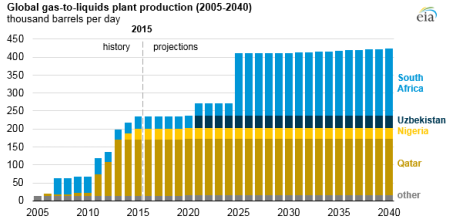EIA: Global GTL growth is dominated by two projects in South Africa and Uzbekistan
EIA’s International Energy Outlook 2017 (IEO2017) projects that liquids produced at gas-to-liquids (GTL) plants will increase as two large-scale projects are completed in South Africa and Uzbekistan. Most of the new GTL capacity will come from the conversion of Sasol’s coal-to-liquids plant in Secunda, South Africa, to a GTL facility. That conversion is expected to be completed by 2024. A previously delayed GTL facility in Uzbekistan is also expected to come online by 2021.
 |
| Courtesy of EIA. |
Gas-to-liquids technologies typically use the Fischer-Tropsch Process to convert natural gas to petroleum products. The resulting products include diesel and gasoline, as well as waxes. EIA estimates global production from GTL facilities currently averages about 230,000 barrels per day (bpd), or about 0.2% of global liquids production. As of the beginning of 2017, more than 90% of this GTL production comes from four projects: two in Qatar, one in South Africa, and one in Nigeria.
In the IEO2017 Reference case, EIA does not expect any other large-scale GTL plants to be built or expanded through 2040. Large GTL plants are capital intensive, and their economics depend on the price of crude oil relative to natural gas. Some countries with GTL facilities lack domestic oil resources but have access to natural gas. GTL plants allow these countries to convert natural gas to petroleum products.
Many previously planned expansions of existing GTL facilities have been put on hold, and additional expansions are not expected under projected market conditions. Aside from the South Africa and Uzbekistan projects, EIA expects the remaining growth in GTL output to come from relatively small facilities, each with a capacity of 5,000 bpd or less.
Small GTL facilities can be modular, with prefabricated process units that are shipped to project sites and linked together instead of being built from the ground up in the field. Modular plants can be shipped and assembled in natural gas-producing regions with insufficient infrastructure to transport natural gas.
Some of these projects may also include microchannel reactors that use small reactors to convert natural gas to liquids more efficiently but limit the overall throughput of a facility. Small-scale GTL projects can reduce flared natural gas from in-field production and emissions from landfills. Production from small-scale GTL plants is not a significant contributor to volumes of petroleum liquids in EIA’s IEO2017 Reference case.
In the IEO2017 High Oil Price case, world crude oil prices are assumed to be much higher than in the IEO2017 Reference case, which provides an incentive to construct new GTL plants or add capacity at existing plants. In the High Oil Price case, global GTL production continues to increase from 2025 through 2040. In the Low Oil Price case, the Uzbekistan project is still assumed to come online, but no other projects (including the South Africa plant) come online after 2021.

- ExxonMobil halts 1-Bft3d blue hydrogen project in Texas
- Aramco and Yokogawa commission multiple autonomous control AI agents at Fadhili gas plant
- Ukraine will resume gas imports via Transbalkan route in November
- Mitsubishi to inject $260 MM into Brunei LNG project
- Freeport LNG (U.S.) on track to take in more natgas on Thursday after unit outage



Comments